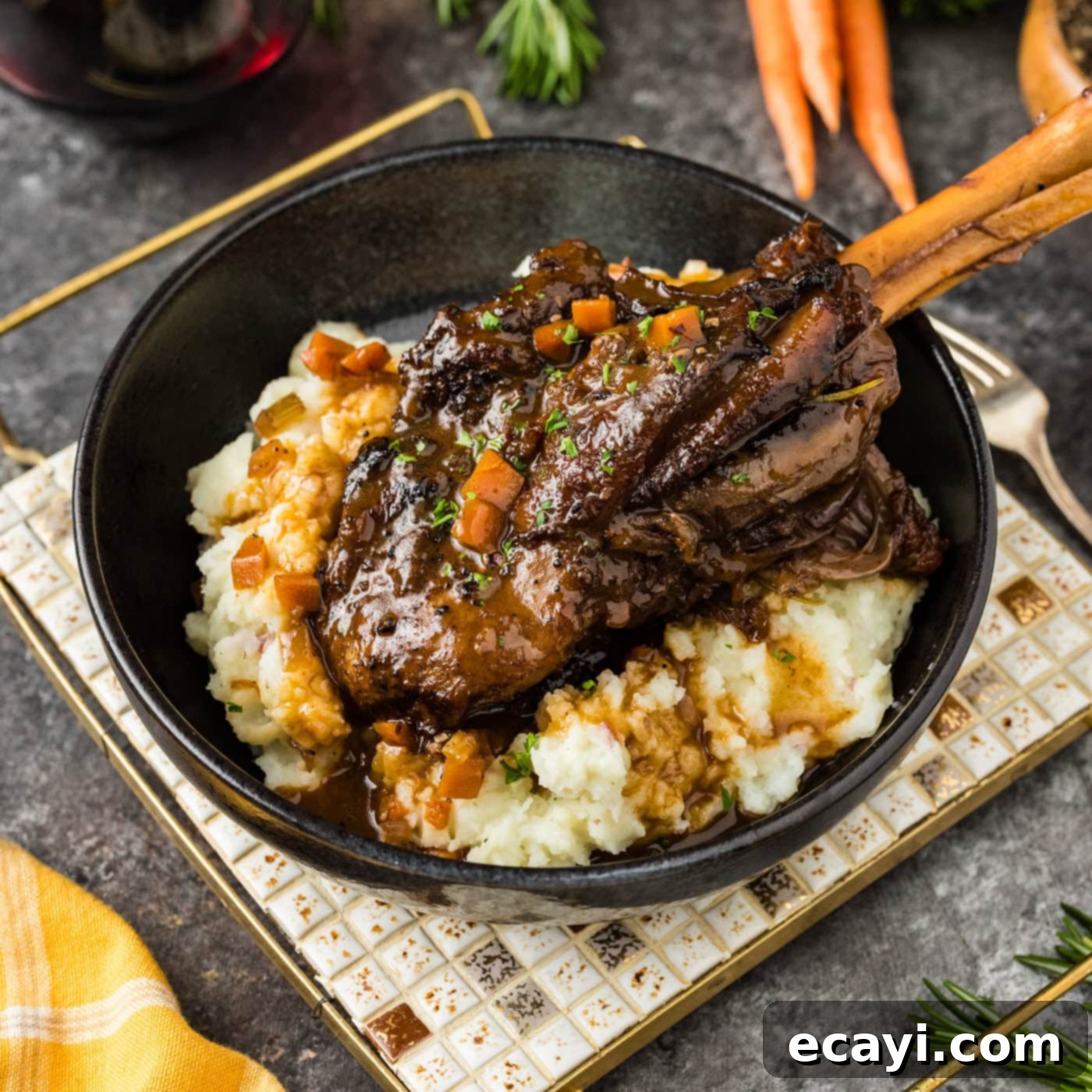The Ultimate Braised Lamb Shanks Recipe: Achieve Fall-Off-The-Bone Tenderness Every Time
Prepare for a culinary masterpiece with these exquisite braised lamb shanks. Slow-cooked to perfection with a medley of aromatic vegetables in a rich, velvety red wine-based sauce, this recipe guarantees lamb so tender it effortlessly falls off the bone. It’s truly the best method to transform a humble cut into an unforgettable gourmet experience, perfect for special occasions or a comforting meal on a chilly evening.
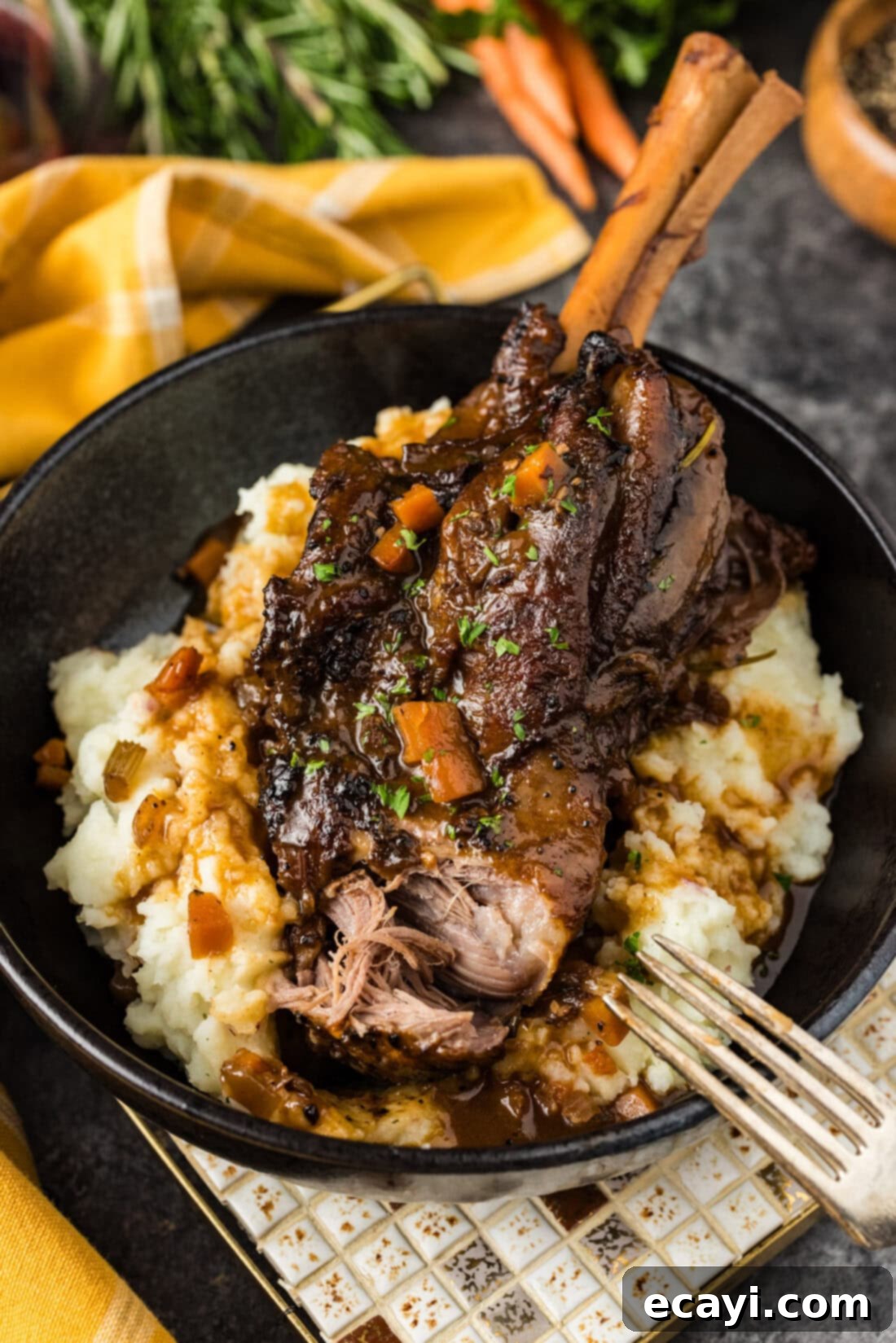
Why This Braised Lamb Shanks Recipe Works So Well
This braised lamb shanks recipe isn’t just visually stunning; it delivers an unparalleled depth of flavor that will delight your taste buds. The magic lies in the traditional braising technique, which transforms a tough cut of meat into something incredibly succulent and tender. By slowly cooking the lamb shanks in a luxurious bath of red wine, alongside foundational aromatics like onion, celery, garlic, and carrots, plus fresh rosemary and fragrant bay leaves, you create layers of complex, savory flavor that permeate every fiber of the meat.
Lamb shanks, sourced from the lower part of the lamb’s leg, are naturally rich in connective tissue. While this makes them less suitable for quick cooking methods, it makes them absolutely ideal for braising. The long, slow cooking process at a low temperature gently breaks down these tough fibers and collagen, converting them into rich, melt-in-your-mouth gelatin. This not only tenderizes the meat but also enriches the braising liquid, turning it into a glossy, intensely flavorful sauce. When served osso buco style with creamy mashed potatoes, polenta, or a decadent risotto, the tender lamb and savory sauce create a dining experience that feels both gourmet and deeply comforting.
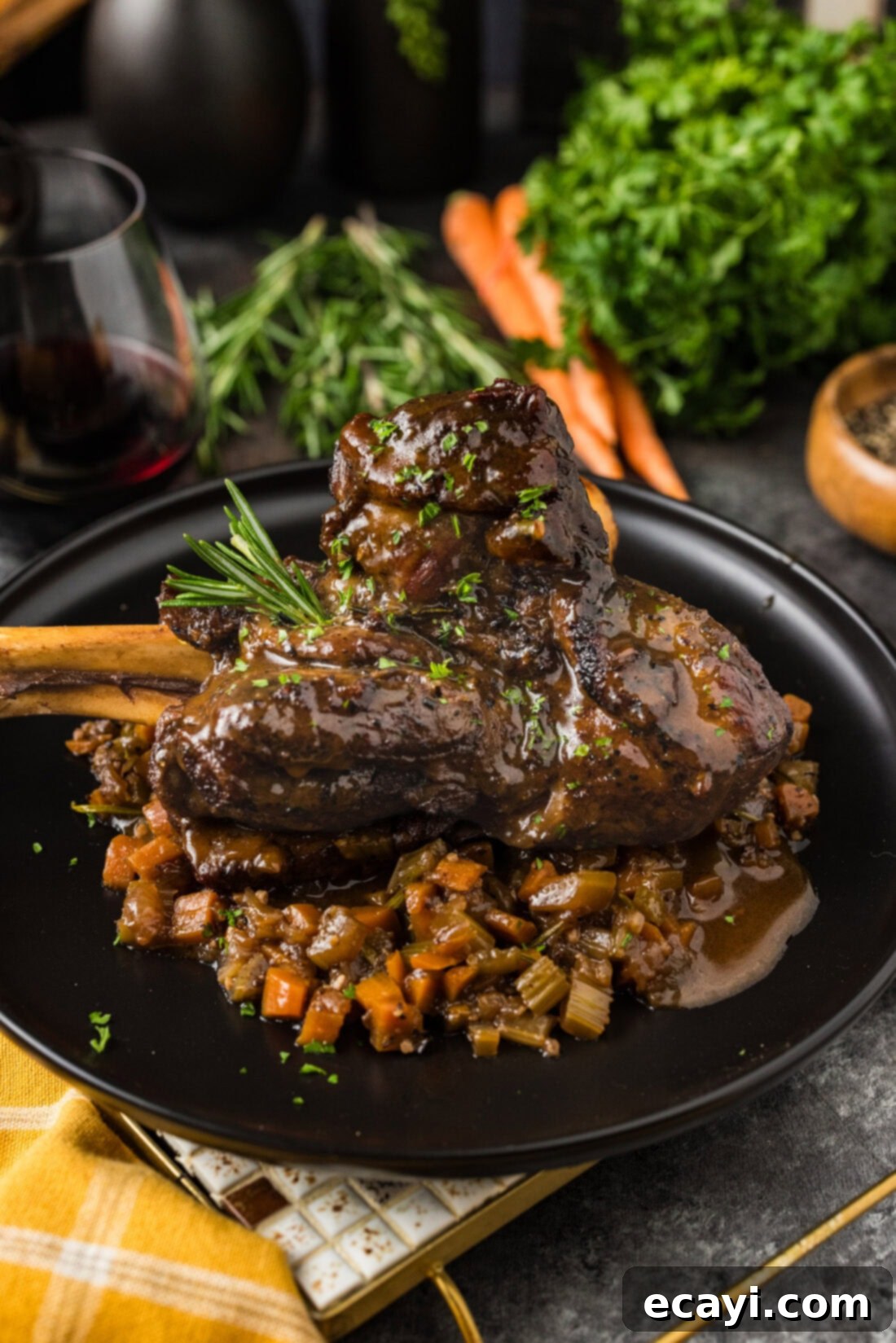
Key Ingredients for Perfect Braised Lamb Shanks
Crafting exceptional braised lamb shanks starts with selecting quality ingredients that contribute to the dish’s rich aroma and profound taste. Below, we delve into the essential components that make this recipe a triumph. For precise measurements and step-by-step instructions, please refer to the printable recipe card located at the end of this post.
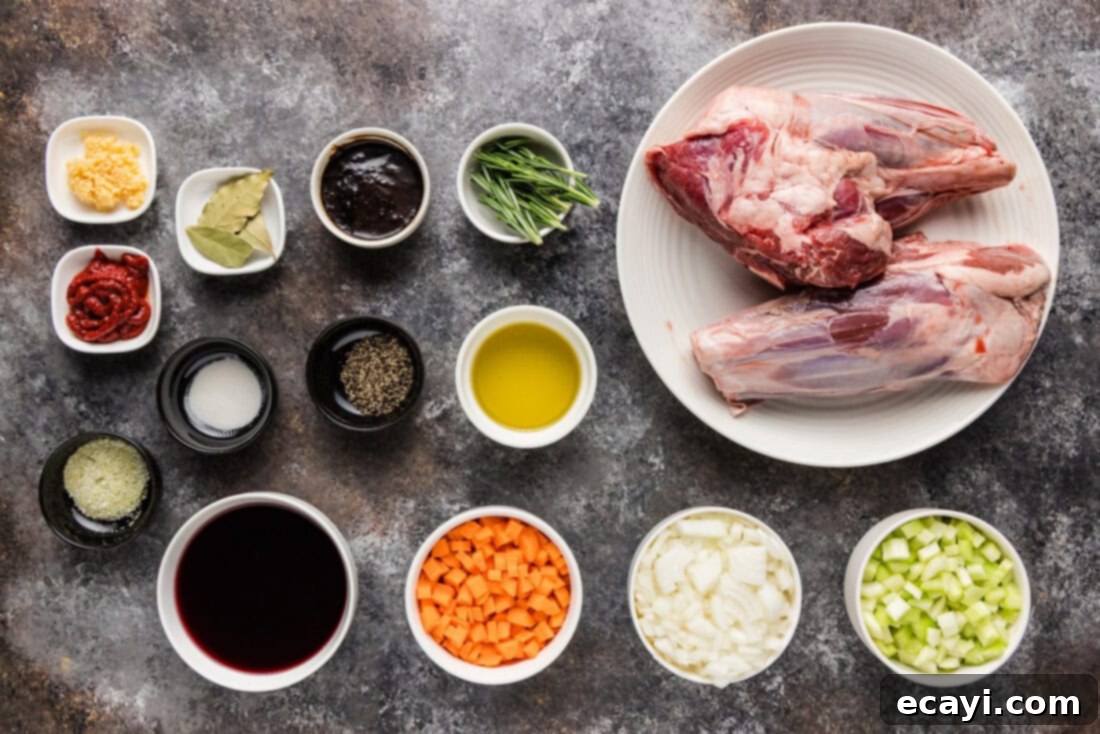
Ingredient Spotlight & Expert Substitution Tips
Understanding each ingredient’s role and knowing how to make smart substitutions can elevate your cooking and ensure delicious results every time.
LAMB SHANKS – As the star of this dish, choosing the right lamb shanks is crucial. You’ll typically find them at the meat counter of your local grocery store or from a reputable butcher. Look for shanks with a good amount of meat on them, and a visible bone, which will infuse the braising liquid with even more flavor. For this recipe, approximately 3 1/2 pounds, usually equating to 2 shanks, is perfect for serving four people generously. Lamb shanks are a fantastic, economical cut that, with patient cooking, yields incredible tenderness and flavor.
VEGETABLES – Our go-to aromatic base, known as mirepoix, consists of onions, celery, carrots, and plenty of garlic. These vegetables don’t just add bulk; they slowly caramelize and sweeten the braising liquid, forming the foundational layer of flavor for the rich sauce. However, feel free to get creative with substitutions based on what you have on hand or what you prefer. Leeks can offer a milder, sweeter alternative to onions, while parsnips can complement the carrots with their earthy sweetness. Mushrooms, especially cremini or shiitake, are excellent for adding an umami depth that pairs beautifully with lamb. Even a few cubed potatoes could be added for a one-pot meal, though they might absorb some of the rich liquid.
WINE – The red wine is indispensable in this recipe, adding crucial acidity, robust color, and a layer of complex fruity and earthy notes to the braising liquid. The acidity helps to tenderize the meat further and deglaze the pot, lifting all those flavorful browned bits (the “fond”) from the bottom, which are packed with umami. You don’t need an expensive bottle, but opt for a dry red wine that you genuinely enjoy drinking, as its flavor will concentrate in the sauce. Cabernet Sauvignon, Merlot, and Zinfandel are classic choices that pair exquisitely with lamb. Don’t worry about the alcohol content; most of it evaporates during the long cooking process, leaving behind only its wonderful flavor. If you prefer to avoid alcohol, a good quality beef stock or even non-alcoholic red wine can be used as a substitute, though the flavor profile will be slightly different.
BOUILLON – For convenience and intense flavor, we frequently use a concentrated bouillon base in our recipes, such as “Better Than Bouillon.” It takes up minimal pantry space and consistently delivers a more robust flavor compared to many canned broths or stocks. The base is easily reconstituted with water. Should you prefer to use traditional broth or stock, simply replace the specified amount of water in the recipe with your chosen stock and omit the bouillon base entirely. This gives you flexibility based on your preference and pantry staples.
HERBS & SPICES – Fresh rosemary sprigs and bay leaves are vital for imparting that classic, earthy, and aromatic essence to the lamb. Rosemary’s piney notes complement lamb beautifully, while bay leaves add a subtle, savory depth. Proper seasoning with garlic salt and black pepper throughout the cooking process ensures every layer of the dish is perfectly balanced.
TOMATO PASTE – This unassuming ingredient packs a powerful punch, adding concentrated umami, a slight sweetness, and a beautiful richness and color to the braising liquid. Don’t skip browning it briefly with the vegetables to deepen its flavor.
How to Master Braised Lamb Shanks: Step-by-Step Guide
These step-by-step photos and instructions are here to help you visualize how to make this recipe. You can Jump to Recipe to get the printable version of this recipe, complete with measurements and instructions at the bottom.
- Preheat your oven: Set your oven to 350°F (175°C). This ensures a consistent, gentle heat for the long braising process, which is key to tender lamb.
- Season the lamb shanks: Pat the lamb shanks dry with paper towels – this helps achieve a better sear. Rub 2 tablespoons of olive oil generously all over the shanks, then season both sides thoroughly with 1 teaspoon of garlic salt and 1/2 teaspoon of black pepper. Don’t be shy with the seasoning; it forms the initial flavor profile.
- Heat the Dutch oven: Add the remaining 2 tablespoons of olive oil to a heavy-bottomed Dutch oven (a 6-quart size is ideal) and heat it over medium-high heat until the oil is shimmering. A hot pan is crucial for a good sear.
- Sear the lamb shanks: Carefully place the seasoned lamb shanks into the hot Dutch oven. Sear them well on all sides, turning occasionally, until a beautiful golden-brown crust forms, about 4-5 minutes total. This browning, known as the Maillard reaction, adds incredible depth of flavor to the meat and the final sauce. Once seared, remove the shanks and set them aside.
- Sauté the vegetables: To the same oil and delicious drippings in the Dutch oven, add the chopped onion, celery, carrots, the remaining 1 teaspoon of garlic salt, and 1/2 teaspoon of black pepper. Sauté for about 2 minutes until they start to soften. Then, add the minced garlic and sauté for another 2 minutes until fragrant. Avoid burning the garlic.
- Build the sauce base: Stir in the tomato paste, beef base (if using), and dry red wine. Bring this mixture to a gentle boil, scraping the bottom of the pot with a wooden spoon to loosen any browned bits from the searing and sautéing. This “deglazing” step incorporates all those flavorful bits into the sauce.
- Combine and simmer: Return the seared lamb shanks to the pot. Add the water; it should almost cover the meat (it’s fine if the shanks are completely immersed). Bring the liquid back to a gentle boil, then reduce the heat and allow it to simmer for 4-5 minutes. Finally, add the fresh rosemary sprigs and bay leaves, nestling them amongst the lamb shanks.
- Braise in the oven: Remove the Dutch oven from the heat and place the cover securely on top. Transfer the covered pot to your preheated oven and bake for 2 1/2 hours. This slow, steady braising ensures the lamb becomes incredibly tender.
- Rest the lamb: Once baked, carefully remove the shanks from the pot and set them aside on a plate. Tent them loosely with aluminum foil to keep them warm while you prepare the sauce. Resting the meat allows the juices to redistribute, ensuring moist and flavorful lamb.
- Strain the braising liquid: Strain the braising liquid through a fine-mesh sieve into a separate bowl or fat separator, discarding the cooked solids (vegetables and herbs). Skim any excess fat off the top of the liquid. A fat separator makes this task particularly easy.
- Make the gravy: To create a rich gravy, whisk 2 teaspoons of cornstarch or flour into a small amount of cold water to form a slurry. Slowly whisk this slurry into the strained braising liquid over medium heat, bringing it to a simmer until the sauce thickens to your desired consistency. Season with additional salt and pepper to taste, if needed.
Frequently Asked Questions & Expert Tips for Braised Lamb Shanks
Absolutely! If you prefer not to use red wine, a high-quality beef stock or broth is an excellent substitute. While the wine adds a unique depth and acidity, beef stock will still provide a rich, savory base for the braising liquid. You can also use non-alcoholic red wine substitutes, though ensure they are unsweetened to maintain the intended flavor profile.
Store any leftover braised lamb shanks and their sauce in an air-tight container in the refrigerator for up to 4 days. Because lamb shanks become incredibly delicate after braising, we highly recommend reheating them gently in a 300°F (150°C) oven. Place the shanks in an oven-safe dish, cover tightly with aluminum foil, and bake for 20-25 minutes, or until heated through. Microwaving can sometimes dry out the meat or make the sauce less appealing. If the sauce appears too thick upon reheating, you can add a splash of water or beef stock to loosen it to your desired consistency.
Yes, this dish is fantastic for making ahead! In fact, many chefs agree that braised dishes often taste even better the next day, as the flavors have more time to meld and deepen. You can prep a few components ahead of time, such as chopping all your vegetables and measuring out other ingredients, keeping them covered and refrigerated until you’re ready to cook. For a full make-ahead meal, prepare the entire dish, let it cool completely, then refrigerate. Reheat following the instructions for leftovers. This makes it a perfect dish for entertaining!
Braised lamb shanks freeze exceptionally well. Allow the shanks and sauce to cool completely. Transfer them to freezer-safe containers or heavy-duty freezer bags, ensuring the lamb is submerged in the sauce to prevent drying out. They can be frozen for up to 3-4 months. Thaw overnight in the refrigerator before reheating gently in the oven.
The primary secret is time and low heat. Braising works by slowly breaking down the collagen in tougher cuts. Resist the urge to rush the cooking process. A tight-fitting lid on your Dutch oven is also crucial to trap moisture and create a steamy environment that aids in tenderization. Don’t lift the lid too often during cooking! Additionally, searing the shanks properly before braising not only locks in flavor but also helps create a flavorful crust that holds up during the long cook time.
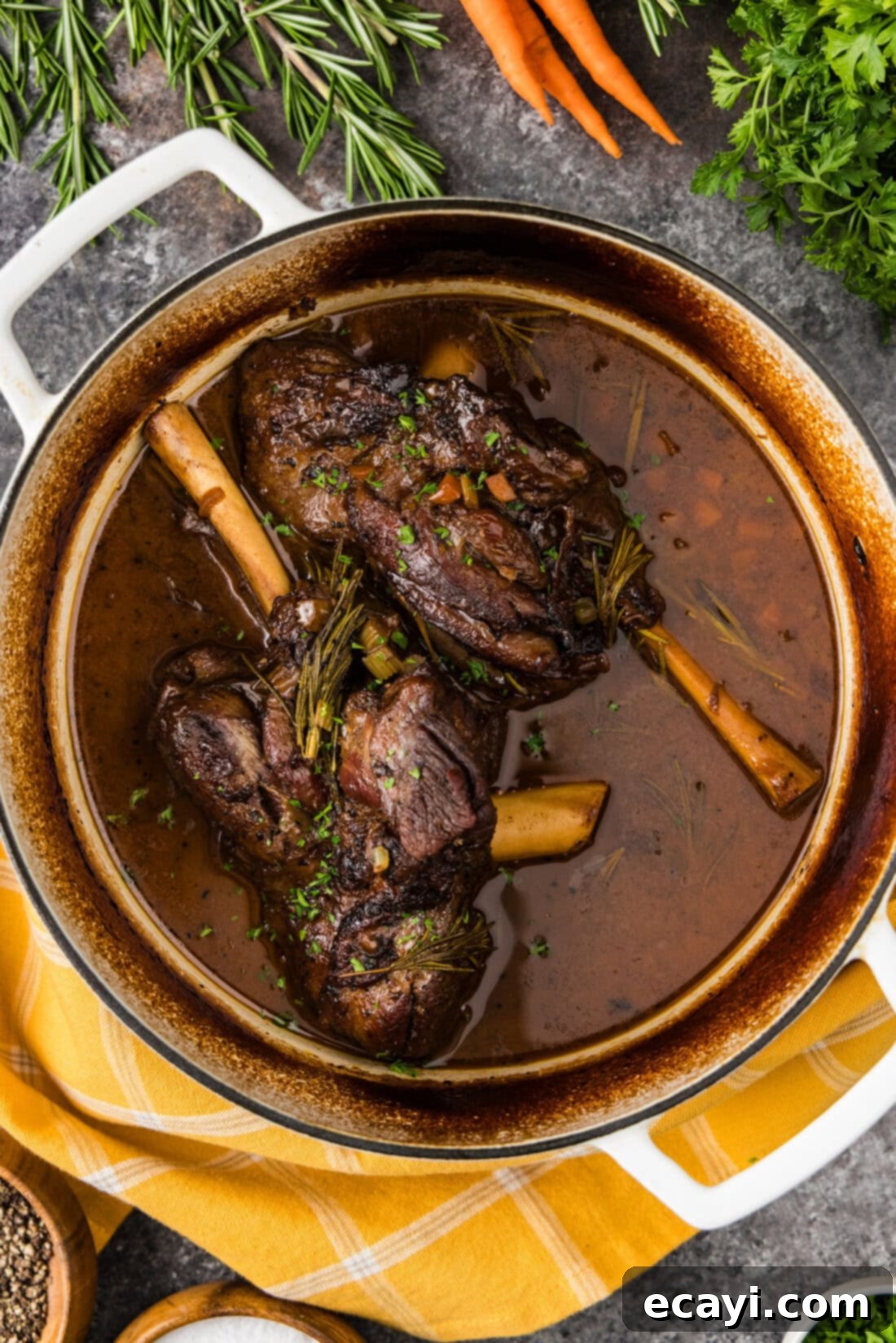
Serving Suggestions for Braised Lamb Shanks
The rich, flavorful sauce from braised lamb shanks is truly a highlight, and the best accompaniments are those that can soak up every last drop. Serve your incredibly tender lamb shanks over a generous bed of creamy mashed potatoes (garlic mashed potatoes are a fantastic choice!), smooth polenta, luxurious risotto, or fluffy couscous. These starchy sides not only provide a perfect textural contrast but also act as a sponge for the delectable braising liquids. For a balanced meal, pair this hearty main course with a crisp, leafy dinner salad dressed with a light vinaigrette, or a side of steamed green beans, roasted asparagus, or glazed carrots to add some vibrant color and freshness.
Explore More Delicious Lamb Recipes
If you love the rich, distinct flavor of lamb, here are more recipes to inspire your culinary adventures:
- Perfectly Seared Lamb Chops
- Elegant Herb-Crusted Rack of Lamb
- Flavorful Lamb Meatballs with Yogurt Sauce
- Quick & Easy Lollipop Lamb Chops
I love to bake and cook and share my kitchen experience with all of you! Remembering to come back each day can be tough, that’s why I offer a convenient newsletter every time a new recipe posts. Simply subscribe and start receiving your free daily recipes!
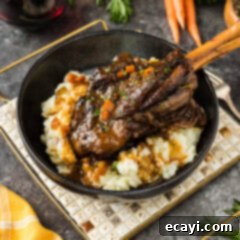
Braised Lamb Shanks
IMPORTANT – There are often Frequently Asked Questions within the blog post that you may find helpful. Simply scroll back up to read them!
Print It
Pin It
Rate It
Save ItSaved!
Ingredients
- 3 ½ pounds lamb shanks 2 shanks
- 4 Tablespoons olive oil divided
- 2 teaspoons garlic salt
- 1 teaspoon black pepper
- 1 cup chopped onion
- 1 cup chopped celery
- 1 cup chopped carrots
- 1 Tablespoon minced garlic
- 1 Tablespoon tomato paste
- 2 Tablespoons Better than Bouillon beef base
- ½ cup dry red wine
- 3 cups water
- 2 sprigs fresh rosemary
- 3 bay leaves
- 2 teaspoons cornstarch or flour optional for thickening gravy
Things You’ll Need
-
6 qt Dutch Oven
-
Fat separator
Before You Begin
- Cabernet Sauvignon, Merlot, or Zinfandel are all great dry red wine choices for braising lamb. Pinot Noir can also be a wonderful option for a slightly lighter, fruitier note.
- For a lower carb version of the gravy, use xanthan gum as your thickening agent instead of cornstarch or flour. Start with a very small amount (e.g., ¼ teaspoon) as it is a much more potent thickener.
- We use a concentrated bouillon base for most of our recipes instead of broth or stock. It’s convenient, takes up a lot less space, and we have found that it has a more intense flavor, and is easily reconstituted with water. You can certainly use broth or stock instead. Just replace the amount of water in the recipe with stock and omit the base.
Instructions
-
Preheat oven to 350 F.
-
Rub 2 Tablespoons of the olive oil all over the lamb shanks. Season both sides with 1 teaspoon of the garlic salt and 1/2 teaspoon of the pepper.3 1/2 pounds lamb shanks
-
Add remaining 2 Tablespoons of the olive oil to the Dutch oven and heat over medium-high heat until shimmering.
-
Add lamb shanks and sear well on both sides, about 4-5 minutes total. Remove from heat and set aside.
-
To the oil in the Dutch oven add onion, celery, carrots, remaining 1 teaspoon garlic salt, and remaining 1/2 teaspoon black pepper. Saute for 2 minutes then add garlic. Saute another 2 minutes.1 cup chopped onion, 1 cup chopped celery, 1 cup chopped carrots, 1 Tablespoon minced garlic
-
Stir in tomato paste, beef base, and red wine. Bring to a gentle boil.1 Tablespoon tomato paste, 2 Tablespoons Better than Bouillon beef base, 1/2 cup dry red wine
-
Add shanks back to the pot and add water (should almost cover the meat, it’s okay if it’s completely immersed). Bring to a gentle boil and allow to simmer for 4-5 minutes. Add rosemary and bay leaves.3 cups water, 2 sprigs fresh rosemary, 3 bay leaves
-
Remove from heat and place cover on Dutch oven. Place covered pot in preheated oven and bake for 2 1/2 hours.
-
Remove shanks from the pot and set aside. Tent with foil to keep warm.
-
Strain and reserve liquid, discarding the solids. Skim fat off the liquid, we like to use a fat separator.
-
To make a gravy, whisk cornstarch or flour into the liquid.2 teaspoons cornstarch or flour
Expert Tips & FAQs
- Store leftovers in an air-tight container kept in the refrigerator for up to 4 days. Because lamb shanks are so delicate, I would recommend reheating them in a 300F oven covered with aluminum foil for 20-25 minutes as opposed to microwaving them. If needed, you can add a splash of water or beef stock to help loosen the sauce.
- Always pat your lamb shanks dry before searing to achieve the best possible brown crust, which maximizes flavor development.
- Don’t overcrowd your Dutch oven when searing. If necessary, sear the shanks in batches to ensure they brown rather than steam.
- For a deeper flavor, you can marinate the lamb shanks in the red wine and herbs overnight in the refrigerator before searing.
- When making the gravy, ensure your cornstarch or flour is fully dissolved in cold liquid before adding it to the hot sauce to prevent lumps.
Nutrition
The recipes on this blog are tested with a conventional gas oven and gas stovetop. It’s important to note that some ovens, especially as they age, can cook and bake inconsistently. Using an inexpensive oven thermometer can assure you that your oven is truly heating to the proper temperature. If you use a toaster oven or countertop oven, please keep in mind that they may not distribute heat the same as a conventional full sized oven and you may need to adjust your cooking/baking times. In the case of recipes made with a pressure cooker, air fryer, slow cooker, or other appliance, a link to the appliances we use is listed within each respective recipe. For baking recipes where measurements are given by weight, please note that results may not be the same if cups are used instead, and we can’t guarantee success with that method.
